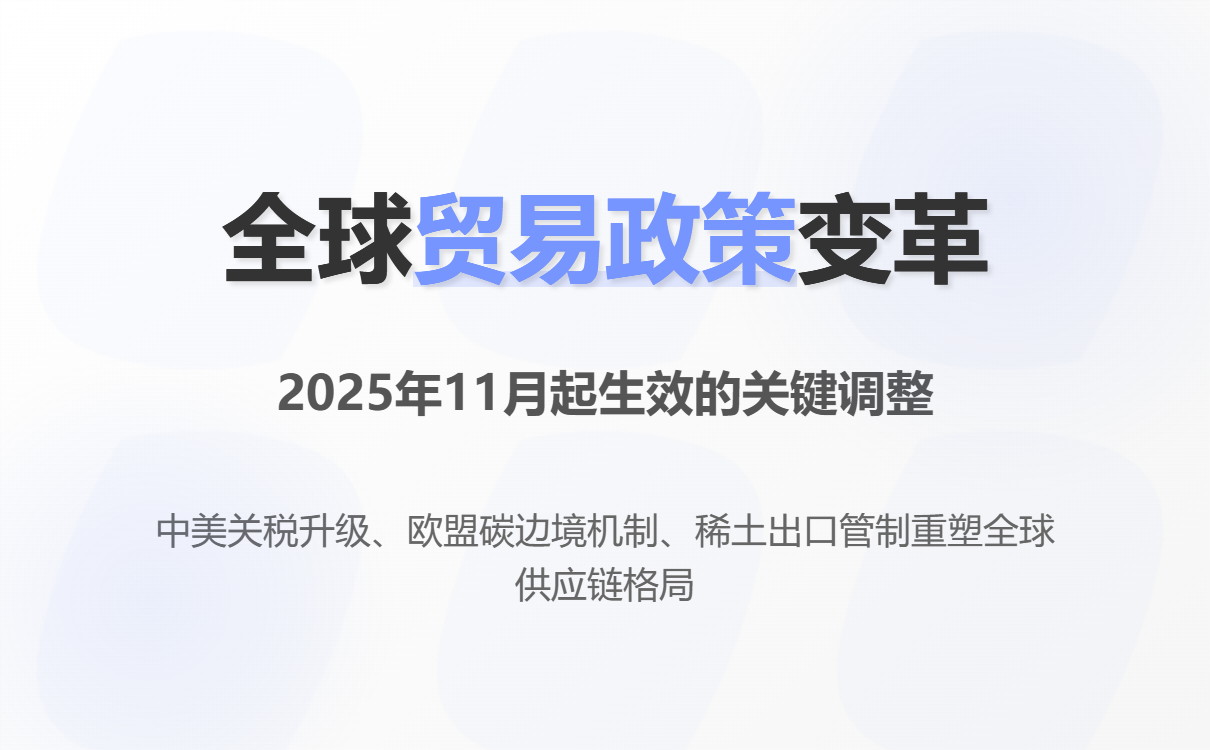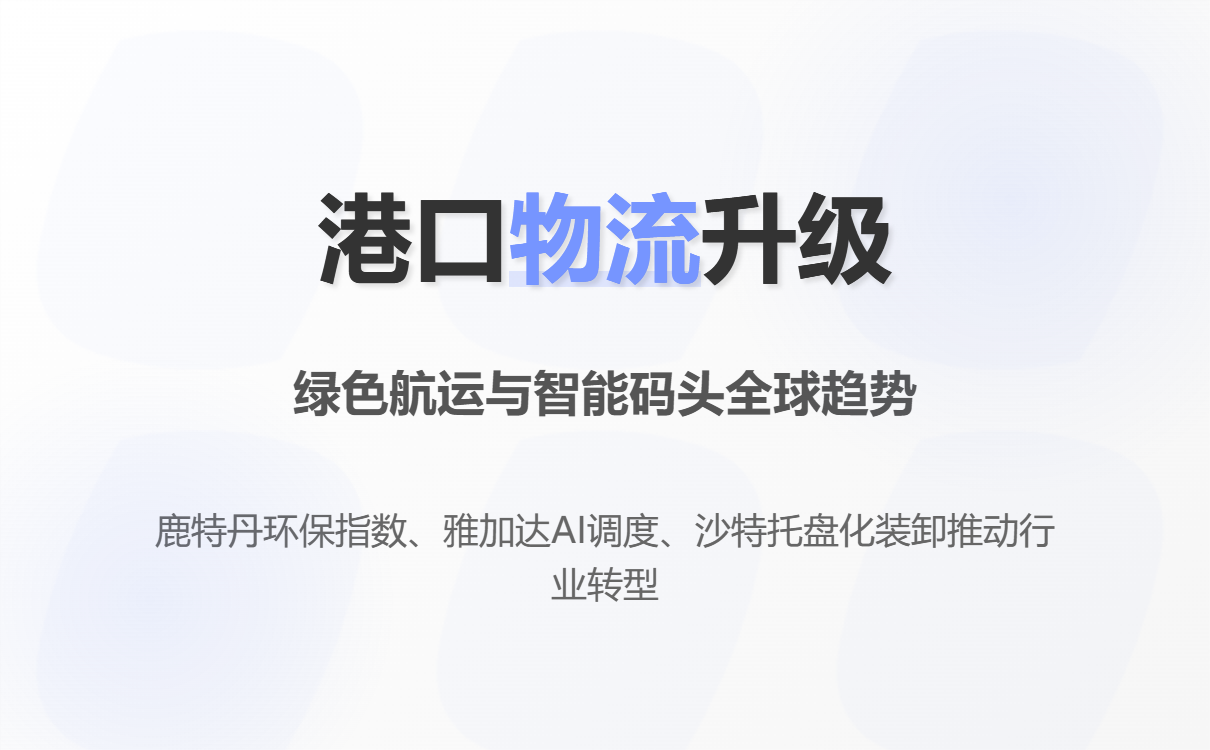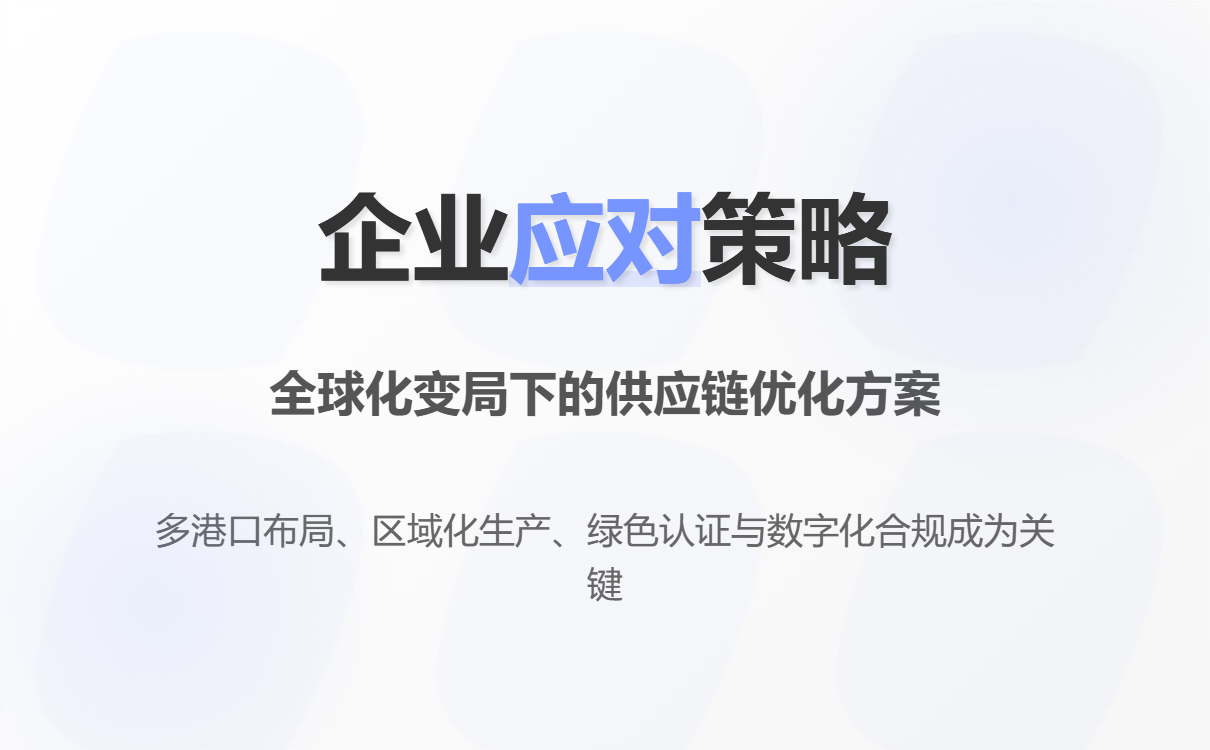
This book reviews the changes in global trade and port/shipping policies that will take effect starting in November 2025, covering new trade regulations, tariff adjustments, customs supervision, cross-border rules, import and export bans, and port/shipping policies in various countries and regions. The global trade environment is facing multiple drivers, including geopolitics, green transformation, regional cooperation, and rising logistics costs.

Effective November 9, the United States imposed a 100% additional tariff (double the existing tariff) on certain Chinese-made port equipment, including ship-to-shore cranes, container chassis, and their components. This move is intended to weaken China's competitiveness in maritime logistics equipment and directly impact Chinese exporters and the global port equipment supply chain.
Effective November 1st, the United States imposed a 25% tariff on imported medium- and heavy-duty trucks and their parts, and a 10% tariff on imported passenger cars. This policy primarily targets countries that are members of the USMCA (United States-Mexico-Canada Agreement), but its exemptions require companies to relocate production to North America, raising costs in the global automotive supply chain.
Regarding the above-mentioned tariffs on trucks and other items, the United States has given a 90-day exemption window: China and the United States will suspend the imposition of the 24% additional tariff until November 10, and only retain the original 10% base tariff.
Background: The U.S. trade monitoring report pointed out that the United States will increasingly use measures such as "Section 232" to impose tariffs on imported products that constitute national security or industrial dependence.
Under the USMCA, tariff-rate quotas for textiles and agricultural products, which took effect on January 1, 2025, will continue until the end of the year. However, as of November, utilization rates for some quotas have reached their upper limits. Businesses need to plan ahead to avoid rising tariff costs.
Starting November 4th, Mexico implemented new technical regulations for low-power radio equipment, requiring compliance with the new standards for four categories of low-power devices, including wireless microphones and hearing aids. These regulations exclude dedicated frequency bands designated in the National Frequency Allocation Table (NFAT) for emergency communications, public safety, and other purposes.
Starting from October 25, Chile canceled the VAT exemption for packages below US$41. Buyers of cross-border direct orders between US$0 and US$500 must prepay 19% import VAT. The new regulations cover all e-commerce platforms and aim to combat tax evasion and balance competition between cross-border e-commerce and local retail.
On June 10, 2025, the Brazilian National Institute of Industrial Property (BPTO) issued Decree No. INPI/PR15/2025, formally recognizing that trademarks lacking inherent distinctiveness can be granted protection by demonstrating acquired distinctiveness or secondary meaning through evidence of use. This rule, which will take effect on November 28, 2025, is intended to align Brazilian trademark examination practices with international standards.
Regulation (EU) 2025/2083, which came into effect on October 20, introduced a "single quality threshold" exemption for the Carbon Border Adjustment Mechanism (CBAM). Annual imports of CBAM-applicable goods (such as steel and aluminum) below 50 tons are exempt from reporting obligations; however, imports exceeding this amount face penalties of €300–500 per ton of embedded emissions. At the same time, the certificate purchase ratio was reduced from 80% to 50% to ease cash flow pressure on businesses.
Starting in November, the European Union is considering new regulations requiring Chinese companies selling new energy vehicles (NEVs) in Europe to hand over core secrets such as battery technology and control systems and to use European workers and parts. This measure, intended to support the domestic industry, could exacerbate trade frictions between China and the EU.
The draft Industrial Accelerator Act proposes to require all non-EU companies to source at least 40% of the raw materials and manufacturing processes for key industrial products such as batteries and energy storage from the EU; if companies refuse to transfer technology, they must establish joint ventures with local EU companies, with the latter holding no less than 35% of the shares.
The Port of Rotterdam implemented a 6% tariff increase from January 1, while also introducing an Environmental Ship Index (ESI) and load factor discounts, allowing ships with high ESI scores or full loads to enjoy tariff reductions.
The Port of Antwerp simultaneously raised tariffs by 2.86%, focusing on supporting green shipping and digital upgrades.
Starting November 8th, China implemented a strict export licensing system for the entire rare earth mining, smelting, separation, and magnetic material manufacturing industry chain. This system also introduced a "0.1% threshold" mechanism: if a foreign product contains 0.1% or more of controlled Chinese-origin ingredients, an export license is required. This measure directly impacts the global supply chain for sectors such as semiconductors and new energy vehicles.
The policy that took effect simultaneously also included lithium batteries and artificial graphite negative electrode materials in the scope of export control, requiring companies to mark the "dual-use item code" when declaring to customs, restricting exports to sensitive technology fields.
Under the framework of the Regional Comprehensive Economic Partnership (RCEP), China, Japan, and South Korea have continued to lower tariffs since November, covering auto parts, agricultural products, and more. For example, the tariff on fruit exported from Japan to China will be reduced from 8% to 4%, and the tariff on auto parts will be reduced from 10% to 5%.
South Korea's Ministry of Finance has decided to reduce fuel tax exemptions from November and extend the tax cuts on gasoline, diesel and liquefied petroleum gas (LPG butane) to the end of December 2025.
Starting November 1st, India will require solar panel importers to register products like tempered safety glass and photosensitive semiconductor devices on the Renewable Energy Equipment Import Monitoring System for three months. This measure aims to boost the local photovoltaic industry, but it may delay project implementation and increase import costs.
On October 26, 2025, Timor-Leste officially became the 11th member of the Association of Southeast Asian Nations (ASEAN) at the ASEAN Summit. This move marks the entry of ASEAN regional cooperation into the "full membership" stage.
Myanmar has implemented tariff reductions for nine RCEP member countries since May, and will further expand this to electronic products and textiles from November.
The United States signed agreements with Malaysia, Thailand and other countries to maintain a tariff rate of 19%-20%, but exempted 1,711 tariff items, including semiconductors and agricultural products.
In terms of port automation and logistics reform: Jakarta Port plans to start the automation transformation of its container terminal in November and introduce an artificial intelligence scheduling system to improve efficiency; Haiphong Port (Vietnam) launched a "Green Port" plan to provide port fee discounts for ships using low-sulfur fuel.
The State Bank of Vietnam issued Circular No. 27/2025, stating that from November 1, 2025, cross-border transfers exceeding US$1,000 and domestic electronic transfers exceeding 500 million Vietnamese dong (approximately RMB 135,000) must be reported to the central bank; those carrying more than US$5,000 in cash or 300 grams of gold and other valuables when entering or leaving the country should also actively declare to the customs.
Effective October 29th, Saudi Arabia will require all cargo arriving at its seaports to be pre-declared through the FASAH National Single Window platform. Ocean routes must submit a 72-hour advance declaration, with overdue declarations incurring fines. This measure aims to improve customs clearance efficiency and align with the country's Vision 2030 logistics hub development.
Mandatory policy of palletized loading and unloading at ports: Saudi ports started palletizing cargo loading and unloading in June, with a transition period until May 2025. From November onwards, it will be mandatory to use pallets for general cargo transportation, with exemptions including bulk cargo and heavy machinery.
Starting November 1, the UAE will impose a 5% value-added tax on cross-border e-commerce parcels worth more than 150 dirhams (about 41 US dollars), up from the previous 1,000 dirhams. The policy aims to regulate the e-commerce market and increase fiscal revenue.
South Africa was the subject of a trade policy review by the World Trade Organization in September, which indicated that its average most-favored-nation tariff would be 13.9% in 2025. South Africa plans to implement export subsidies for some agricultural products (such as wine) starting in November to cope with international competition.
Port Upgrades and Logistics Cooperation: The Port of Durban has launched a container terminal expansion project, expected to be completed in 2026 and expected to increase throughput by 30%. Meanwhile, South Africa and the Port of Beira (Mozambique) signed a railway freight cooperation agreement to strengthen rail transport from Beira to Johannesburg.
Starting in February 2026, Australia will implement new regulations requiring imported food to be clearly labeled for 23 allergens (such as tree nuts and aquatic products). However, companies must submit compliance plans starting in November or risk product detention.

The following are the freight rate and surcharge adjustments implemented by several major shipping companies (such as MSC Mediterranean Shipping Company, Maersk, Hapag-Lloyd, and CMA CGM) from November 2025:
| Route range | Fee Adjustment Type | Specific instructions |
|---|---|---|
| Far East → Northern Europe/Mediterranean, Far East → Sub-Saharan Africa, Indian Ocean | FAK (Flat Rate) Adjustment | Effective date: November 1, 2025 (MSC Far East → Northern Europe/Mediterranean, Sub-Sahara) |
| Far East Asia → Middle East, Asia Pacific → South Africa/Mauritius | PSS (Peak Season Surcharge) Adjustment | Maersk: An additional charge of US$300 per container will be added to the Middle East route; the standard for the African route will be adjusted but the specific amount has not been disclosed. |
| Far East → Europe, Far East → West/East South America, Mexico, Central America, Caribbean | FAK rate increase + GRI rate adjustment | Hapag-Lloyd: Covers 20/40 feet dry containers and refrigerated containers, GRI increases by USD 1,000 per container. |
| Asia → Northern Europe | FAK rate adjustment | CMA CGM: Only announced new FAK rates, without disclosing the extent of the adjustment. |
These adjustments indicate an overall increase in shipping costs and heightened supply chain risks. Companies should closely monitor changes in shipping rates, contract terms, and shipping options.

Geopolitics is driving supply chain restructuring : factors such as the Sino-US trade friction, the EU carbon border mechanism, and export controls on key minerals are changing the global industrial and logistics landscape.
Green transformation and digitalization are accelerating : port environmental protection incentives, green rules for free trade zones, electronic customs clearance, and smart terminal construction have become mainstream trends.
Regional cooperation deepens but rule differentiation increases : RCEP and USMCA release dividends, but each region has different structures and compliance costs increase.
Rising shipping costs and risks : port rates are rising, freight surcharges are increasing, customs clearance windows are shortened, and cross-border logistics are more susceptible to policy disruptions.
Sort out global supply chain nodes in advance: focus on the new regulations that will take effect in November, and evaluate changes in costs such as tariffs, regulations, certification, and port service fees.
Strengthen compliance and early warning mechanisms: establish trade policy monitoring, export control compliance, and optimize customs declaration processes.
Optimize logistics and transportation solutions: consider multi-port layout, alternative routes, mixed transportation modes, and long-term negotiated transportation contracts.
Improving green and digital capabilities: Port automation, low-carbon ships, ESI indicators, and traceability of packaging materials/components will become competitive advantages.
Regionalization and localization adaptation: Under mechanisms such as RCEP and USMCA, the use of localized production, regional supply chains, and local compliance can bring cost and speed advantages.
.png?x-oss-process=image/resize,h_100,m_lfit/format,webp)
.png?x-oss-process=image/resize,h_100,m_lfit/format,webp)

.png?x-oss-process=image/resize,h_100,m_lfit/format,webp)
.png?x-oss-process=image/resize,h_100,m_lfit/format,webp)
.png?x-oss-process=image/resize,h_100,m_lfit/format,webp)
.png?x-oss-process=image/resize,h_100,m_lfit/format,webp)
